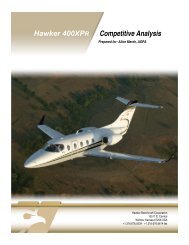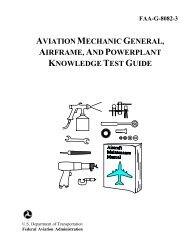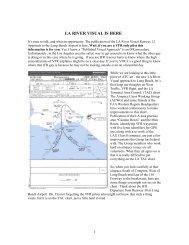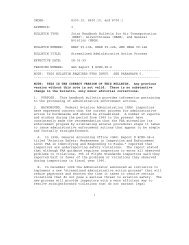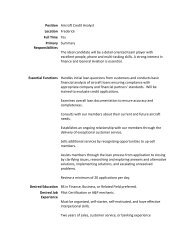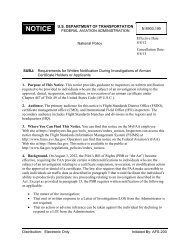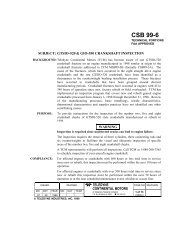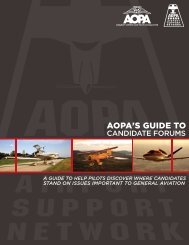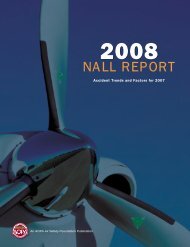Joseph T. Nall Report - Aircraft Owners and Pilots Association
Joseph T. Nall Report - Aircraft Owners and Pilots Association
Joseph T. Nall Report - Aircraft Owners and Pilots Association
Create successful ePaper yourself
Turn your PDF publications into a flip-book with our unique Google optimized e-Paper software.
Causes <strong>and</strong><br />
M<br />
Factors<br />
A J O R A C C I D E N T<br />
T HE A CCIDENT S ETTING—<br />
P HASE OF F LIGHT<br />
Studies conducted by the Boeing Commercial<br />
<strong>Aircraft</strong> Company on commercial jet aircraft accidents<br />
have estimated that takeoff <strong>and</strong> l<strong>and</strong>ing each<br />
constitute only one percent of a typical flight.<br />
Initial climb adds another one percent <strong>and</strong> final<br />
approach accounts for three percent. Cruising<br />
flight was estimated to account for 60 percent of a<br />
typical flight, with the remainder being distributed<br />
fairly evenly between climb to altitude, descent<br />
from altitude, <strong>and</strong> initial approach.<br />
The majority of accident sequences begin during<br />
phases of flight that take up relatively little<br />
flight time but contain the highest number of critical<br />
tasks <strong>and</strong> the highest task complexity. Compare<br />
the proportions of accidents occurring in the takeoff,<br />
cruise, approach, <strong>and</strong> l<strong>and</strong>ing phases, <strong>and</strong> it is<br />
easy to see that there are significant hazards in the<br />
phases of flight that account for only a small portion<br />
of flight time.<br />
GA operations usually involve many more takeoffs<br />
<strong>and</strong> l<strong>and</strong>ings per flight hour than airlines.<br />
Instructors <strong>and</strong> their students sometimes spend<br />
entire flight lessons in the traffic pattern.<br />
Nevertheless, the critical relationships between<br />
phases of flight remain basically the same. For both<br />
GA <strong>and</strong> commercial flights, takeoffs <strong>and</strong> l<strong>and</strong>ings,<br />
although the most complex phases of flight, constitute<br />
a relatively small portion of the total flight<br />
time.<br />
The chart to the right classifies pilot-related<br />
accidents according to the phase of flight in which<br />
the situation that resulted in the accident began.<br />
For example, fuel exhaustion or an encounter with<br />
low weather may have caused the pilot to make a<br />
precautionary l<strong>and</strong>ing. Although the accident actually<br />
occurred during this l<strong>and</strong>ing, the “emergency<br />
phase” of flight would be cruise.<br />
One phase in which accident proportions in GA<br />
consistently differ from commercial flying is in<br />
cruise. Weather is usually the culprit in these situations<br />
where more GA pilots fall victim to VFR<br />
flight into IMC. About 58 percent of the GA pilot<br />
population is instrument qualified.<br />
St<strong>and</strong>ing<br />
Taxi<br />
Takeoff<br />
Climb<br />
Cruise<br />
Descent<br />
Approach<br />
Go-Around<br />
L<strong>and</strong>ing<br />
Maneuvering<br />
Unknown<br />
1.3% (7)<br />
1.4% (1)<br />
2.4% (13)<br />
0.0% (0)<br />
1.9% (10)<br />
1.4% (1)<br />
0.9% (5)<br />
4.1% (3)<br />
Emergency Phase of Flight<br />
4.1% (22)<br />
8.2% (6)<br />
3.8% (20)<br />
12.3% (9)<br />
9.2% (49)<br />
13.7% (10)<br />
21.6% (115)<br />
12.3% (9)<br />
12.6% (67)<br />
19.2% (14)<br />
9.6% (51)<br />
23.3% (17)<br />
All Accidents<br />
Fatal Accidents<br />
32.5% (173)<br />
4.1% (3)<br />
0 10 20 30 40<br />
Percent<br />
13



